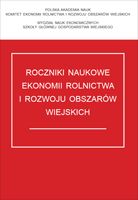Main Article Content
Article Details
Abdulai Awudu, Owusu Victor, Goetz Renan 2011: Land tenure differences and investment in land improvement measures: Theoretical and empirical analyses, „Journal of Development Economics”, vol. 96, no. 1, s. 68-71. (Crossref)
Arnot D. Chris, Luckert K. Martin, Boxall C. Peter 2011: What is tenure security? Conceptual implications for empirical analysis, „Land Economics”, vol. 87, no. 2, s 297-300. (Crossref)
Begg David, Fischer Stanley, Dornbusz Rudiger 1993: Ekonomia, PWE, Warszawa.
Brinkmann T. 1992: Die Ökonomik des landwirtschaftlichen Betriebes. [w] Grundriss der Sozialoekonomik, Tübingen, s. 12.
Czyżewski Bazyli, Trojanek Radosław 2016: Czynniki wartości ziemi rolnej w kontekście zróżnicowanych funkcji obszarów wiejskich w Polsce, „Zagadnienia Ekonomiki Rolnej”, nr 2, s. 10. (Crossref)
Gruszczyński Marek (red.) 2012: Mikroekonometria: Modele i metody analizy danych indywidualnych, Oficyna & Wolters Kluwer Business, Warszawa, s. 268-273.
GUS 2017: Rocznik statystyczny rolnictwa, GUS, Warszawa.Hawawini Gabriel, Viallet Claude 2007: Finanse menedżerskie, Wydawnictwo PWE, Warszawa, s. 52-54.
Kagan Adam, Adamski Marcin, Kulawik Jacek 2012: Funkcjonowanie wielkoobszarowych przedsiębiorstw rolnych a postęp biologiczny, IERiGŻ-PIB, Warszawa, s. 20-23.
Kagan Adam, Ziętara Wojciech 2017: Ekonomiczna efektywność gospodarowania – dzierżawca czy właściciel (próba oceny), „Zagadnienia Ekonomiki Rolnej”, nr 3, s. 75.
Mądra Magdalena 2009: Wpływ poziomu zadłużenia na siłę ekonomiczną gospodarstw rolniczych, „Roczniki Nauk Rolniczych. Seria G”, T. 96, z. 3, s. 192.
Pawlik Stefan 1922: Dzierżawa i umowa dzierżawna, Księgarnia rolnicza, Praktyczna Encyklopedia Gospodarstwa Wiejskiego, nr 39-40, s. 10-15.
Pomykalska Bożena, Pomykalski Przemysław 2007: Analiza finansowa przedsiębiorstw, Wydawnictwo PWN, Warszawa, s. 270-274.
Ranking 300 najlepszych przedsiębiorstw rolnych w 2016 roku, 2018: IERiGŻ-PIB, Warszawa, s. 4-5.
Raport Agencji Nieruchomości Rolnych za 2016 r., ANR, Warszawa 2017, s. 22.
Sikorska Alina 2013: Przemiany w strukturze agrarnej indywidualnych gospodarstw rolnych, IERiGŻ-PIB, Warszawa, s. 10-11.
Statistisches Jahrbuch über Ernährunug 2011-2015: Landwirtschaft und Forsten 2009-2014, Landwirtschaftsverlag, Münster.
Ziętara Wojciech 2016: Dzierżawa ziemi w gospodarstwach rolniczych jako podmiotach biogospodarki, „Roczniki Naukowe SERiA”, T. XVIII, z. 3, s. 305-308.
Downloads
- Maria Miczyńska-Kowalska, Suburbanization of the suburbian zone of Lublin , Annals of Agricultural Economics and Rural Development: Vol. 106 No. 1 (2019)
You may also start an advanced similarity search for this article.
- Wojciech Józwiak, Adam Kagan, Commercial farms and large commercial farms , Annals of Agricultural Economics and Rural Development: Vol. 95 No. 1 (2008)
- Wojciech Ziętara, ORGANISATION AND THE ECONOMICS OF MILK PRODUCTION IN POLAND, TRENDS IN THE PAST AND FUTURE , Annals of Agricultural Economics and Rural Development: Vol. 99 No. 1 (2012)
- Marek Zieliński, Wojciech Ziętara, TECHNICAL EFFICIENCY AND COMPETITIVENESS OF FIELD FARMS , Annals of Agricultural Economics and Rural Development: Vol. 103 No. 1 (2016)
- Wojciech Ziętara, Measures of the size of agricultural farms and agricultural enterprises , Annals of Agricultural Economics and Rural Development: Vol. 96 No. 4 (2009)
- Wojciech Ziętara, SOCIAL OR ECONOMIC NATURE OF THE AGRICULTURAL REFORMS IN POLAND DURING THE INTER- AND POST-WAR , Annals of Agricultural Economics and Rural Development: Vol. 102 No. 1 (2015)
- Wojciech Józwiak, Zofia Mirkowska, Wojciech Ziętara, The role of large agricultural farms in the growth of the productivity of Polish agriculture in the background of the situation in other selected countries of the European Union , Annals of Agricultural Economics and Rural Development: Vol. 105 No. 1 (2018)
- Wojciech Ziętara, Internal conditions of development of Polish agriculture , Annals of Agricultural Economics and Rural Development: Vol. 94 No. 2 (2008)
- Wojciech Ziętara, Marcin Adamski, Zofia Mirkowska, ACTUAL VS. OPTIMAL PERIOD OF THE UTILITY OF DAIRY COWS , Annals of Agricultural Economics and Rural Development: Vol. 100 No. 3 (2013)
- Wojciech Ziętara, Profesor Janusz Kosicki. The life and the work (jubilee of the birthday 80th) , Annals of Agricultural Economics and Rural Development: Vol. 95 No. 1 (2008)
- Wojciech Ziętara, Tendencies in changes of milk production in Poland , Annals of Agricultural Economics and Rural Development: Vol. 96 No. 1 (2009)




